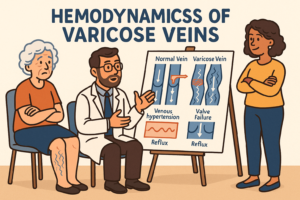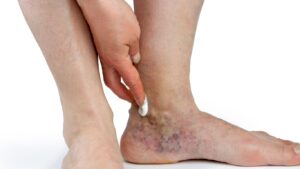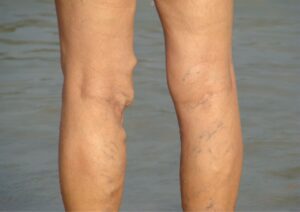Have you ever noticed your legs feeling chilly even when the rest of you is warm? Or looked down and wondered why your skin looks pale, bluish, or patchy? You’re not alone—changes in temperature and color are surprisingly common, and they can happen for all sorts of reasons.
Sometimes it’s related to how blood is flowing through your veins or arteries. Other times, it’s about how your nerves are working. And in a few cases, it’s something less common that still affects how your legs look and feel.
In this article, we’ll walk through the most common causes, what each one tends to look like, and a few unusual conditions that can also play a role. By the end, you’ll have a clearer picture of what might be behind those cold, discolored legs—so you can talk it over with your doctor
Legs can feel cold when warm, oxygen-rich blood isn’t reaching the skin as easily as it should. That can happen if blood flow is slowed, blocked, or uneven, or if the nerves controlling circulation aren’t working quite right. When circulation changes, skin color can shift too—sometimes looking pale or bluish, other times taking on a reddish-brown tint. One pattern, called livedo reticularis, creates a lace-like, purplish network on the skin, often more visible in cooler temperatures. This appearance comes from tiny blood vessels constricting or from sluggish flow in the deeper layers of the skin. There are many reasons these changes can happen, ranging from common conditions like vein or artery problems, to nerve-related issues, to rarer disorders that affect blood vessels, the heart, or the immune system.
Venous Insufficiency
(Problems with Veins)
What happens?
In healthy veins, tiny one-way valves help push blood back up toward your heart, even against gravity. In chronic venous insufficiency (CVI), these valves become weak or damaged—often from aging, long hours of standing, previous blood clots, or pregnancy. When they don’t close properly, blood flows backward and pools in your lower legs. Over time, this extra pressure stretches the veins and damages nearby skin and tissues.
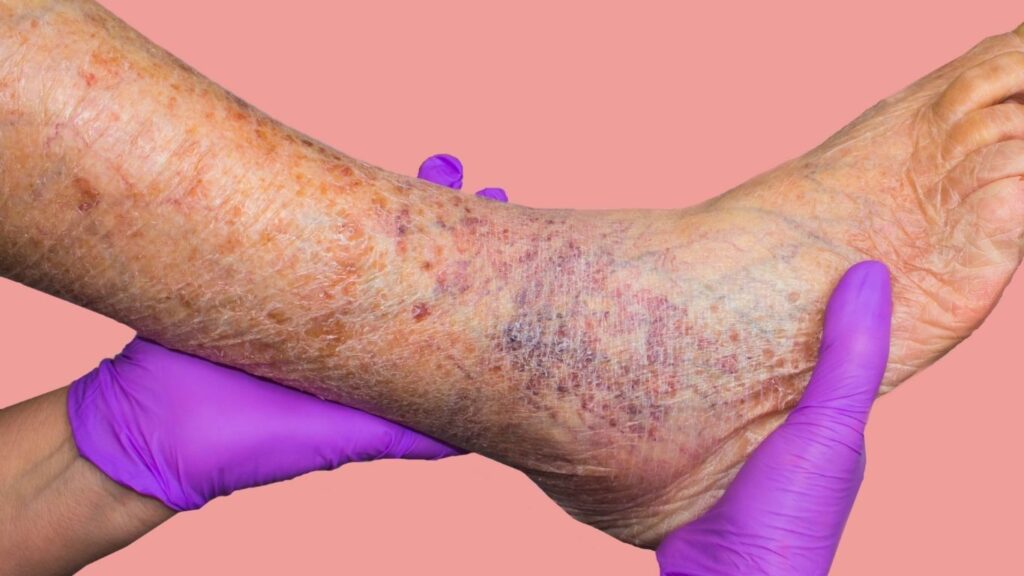
How it looks/feels:
Your legs may feel heavy, achy, or tired, especially by the end of the day.
You might notice swelling (edema) around the ankles or calves, which often improves when you lie down or elevate your legs.
Varicose veins—twisted, bulging blue or purple veins—may appear on the surface.
The skin can develop brownish or reddish patches due to tiny blood cells leaking into the tissues and breaking down.
Some people experience itching, stinging, or burning in the affected areas.
In more advanced cases, skin ulcers (open sores) may form, usually around the inner ankle. These can be slow to heal.
Why it’s cold/discolored:
When blood isn’t moving efficiently, the tissues don’t get the oxygen and nutrients they need. This leads to inflammation and fluid leakage into the surrounding tissue, which can change the skin color over time. The legs might feel cooler than the rest of your body because fresh, warm, oxygen-rich blood isn’t cycling through as quickly. The reddish-brown patches come from iron deposits left behind when red blood cells leak out and break down.
What to do:
See your doctor if you have ongoing swelling, skin changes, or sores that don’t heal—early treatment prevents complications.
- In more advanced cases, your doctor might suggest minimally invasive vein treatments like laser therapy or ablation to improve blood flow.

Neuropathy (Nerve Problems)
What happens?
Your nerves are like electrical wires carrying messages between your brain and body. In neuropathy, these “wires” get damaged—often from diabetes, long-term alcohol use, vitamin deficiencies (especially B vitamins), infections, or certain medications. Damaged nerves can’t send signals properly, so your brain might not know if your legs are hot, cold, injured, or in pain. Sometimes, nerve damage also affects how blood vessels open and close, which can change skin temperature and blood flow.
How it looks/feels:
Numbness or tingling (“pins and needles”) in the feet or legs.
A feeling of burning or shooting pain, especially at night.
Weakness or trouble walking.
Feet and legs may feel cold to the touch—but sometimes, oddly, they can feel warm when touched yet cold in sensation.
Skin color changes are less common than in venous or arterial problems, but if nerves controlling blood vessels are affected, skin might look pale, blotchy, or reddish.
Why it’s cold/discolored:
If the nerves controlling your blood vessels are damaged, the vessels might stay narrowed, which reduces blood flow. Less warm blood reaching your skin can make your legs feel cold. Color changes happen when blood flow is irregular—too little can make skin pale; sudden flushing can make it reddish.
What to do:
Wear protective shoes to avoid injury (you might not feel wounds).
- See a doctor if symptoms are worsening—nerve tests may help guide treatment.
Arterial Problems
(Issues with Arteries / PAD)
What happens?
Your arteries are the “highways” carrying oxygen-rich blood from your heart to your legs and feet. In peripheral artery disease, plaque (a mix of fat, cholesterol, and other substances) builds up in the artery walls, making them narrow and stiff. This is called atherosclerosis. Narrow arteries can’t carry enough blood, especially when your muscles need more—like when you’re walking or climbing stairs.
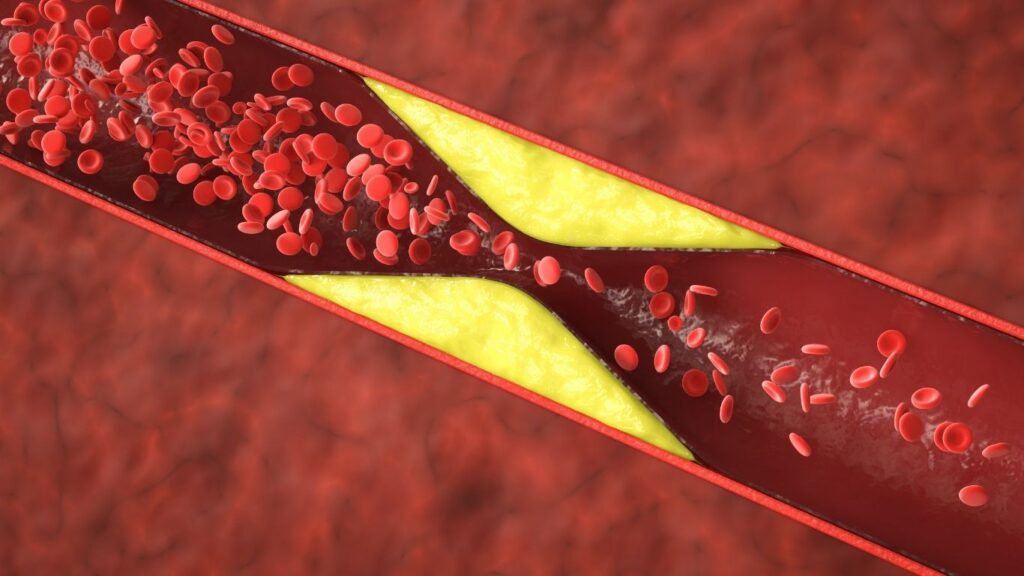
How it looks/feels:
Cold feet and legs that stay cold even under a blanket.
Pale or bluish skin—especially when legs are raised.
Shiny, dry skin and loss of hair on the shins or feet.
Weak or absent pulses in the ankles or feet.
Pain, cramping, or tightness in the calves when walking (claudication), which improves with rest.
Slow-healing wounds or sores on toes/feet.
Why it’s cold/discolored:
When arteries are blocked, less warm, oxygenated blood reaches the skin. Without enough oxygen, skin turns pale or bluish (cyanosis). Over time, tissues can weaken and break down, leading to ulcers.
What to do:
Seek medical help quickly—PAD can lead to serious complications if untreated.
Your doctor may prescribe medications (blood thinners, cholesterol-lowering drugs) or recommend angioplasty or surgery to open blocked arteries
Unusual Presentations and Rare Causes of Cold, Discolored Legs
Deep Vein Thrombosis DVT
A sudden change in leg color, especially if it turns deep red, purple, or bluish, may sometimes be linked to a blockage in the deep veins. This can cause noticeable swelling, discomfort, and warmth in the limb. Because blood flow is disrupted, pressure builds in the veins, creating both color changes and swelling.
Vasospastic Disorders (Raynaud’s Phenomenon)
In some people, blood vessels in the legs or feet can temporarily tighten in response to cold or stress. This may cause the skin to shift in color—from white to blue to red—as blood flow is reduced and then restored. Raynaud’s is better known for affecting the fingers, but it can also appear in the lower limbs.
Inflammation of Blood Vessels (Vasculitis)
When blood vessels become inflamed, they may narrow or close, reducing circulation to the skin and underlying tissue. This can lead to patchy purple areas, redness, or small sore-like spots. The appearance can vary depending on which vessels are involved and how deeply the process affects the skin.
Nerve or Spinal Cord Conditions
Some conditions that affect the spine or major nerves can influence both movement and circulation in the legs. Weakened muscle pumping action or changes in nerve control over blood vessels can make the skin appear pale or feel cool. These changes may occur alongside altered sensation or muscle weakness.
The Bottom Line
Cold, discolored legs can have many different explanations—some common and fairly simple, others less so. Whether it’s sluggish veins, narrowed arteries, nerve changes, or a rare condition affecting blood vessels, each cause leaves its own “signature” in how your legs look and feel. Paying attention to these changes, and how they show up over time, can help you and your healthcare provider piece together what’s going on. While the internet can offer clues, only a proper medical evaluation can confirm the cause. The most important thing is to listen to your body—especially when it’s sending signals in the form of unusual temperature or color changes—and bring those observations to someone who can help you understand them.
Key Takeaways
Cold, discolored legs often point to changes in circulation or nerve function.
Venous insufficiency can cause swelling, heaviness, and brownish patches—especially around the ankles.
Neuropathy may bring numbness, tingling, and cold sensations, sometimes without obvious skin changes.
Arterial problems often lead to pale or bluish skin, coolness, and pain with walking.
Patterns like livedo reticularis create a lace-like, purplish skin appearance when blood flow is uneven.
Rare causes include blood clots, vasospastic disorders, vasculitis, and spinal cord conditions.
Sudden, severe, or rapidly changing symptoms should always be discussed with a healthcare professional.



